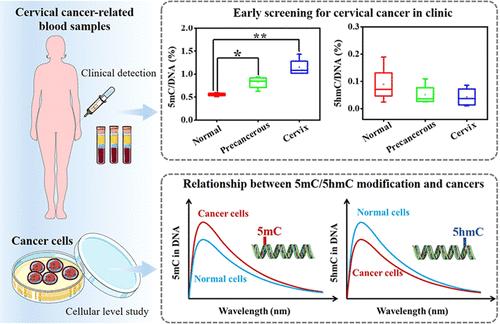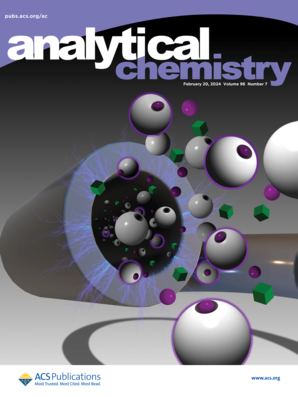Label-Free and Sequence-Independent Isothermal Amplification Strategy for the Simultaneous Detection of Genomic 5-Methylcytosine and 5-Hydroxymethylcytosine
IF 6.7
1区 化学
Q1 CHEMISTRY, ANALYTICAL
引用次数: 0
Abstract
5-Methylcytosine (5mC) and 5-hydroxymethylcytosine (5hmC) are crucial epigenetic modifications in eukaryotic genomic DNA that regulate gene expression and are associated with the occurrence of various cancers. Here, we combined bisulfite conversion with 4-acetamido-2,2,6,6-tetramethyl-1-oxopiperridinium tetrafluoroborate (ACT+BF4–, TCI) oxidation to develop a label-free and sequence-independent isothermal amplification (BTIA) assay for a genome-wide 5mC and 5hmC analysis. The BTIA strategy can distinguish 5mC and 5hmC signatures from other bases with high sensitivity and good specificity, avoiding sophisticated chemical modifications and expensive protein labeling. Moreover, the utilization of terminal deoxynucleotidyl transferase (TdT) enables the proposed strategy to detect global 5mC and 5hmC without sequence dependence. With only 78 ng of input of genomic DNA, global 5mC and 5hmC levels were accurately quantified in cells (including cancer cells of A549, T47D, and K562 and normal cells of HEK-293T, CHO, and NRK-52E) and clinical whole blood samples (including healthy control, precancerous cervical cancer, and confirmed cervical cancer) within 18 h. The detection results suggested that 5mC was highly expressed in cancer cells. More importantly, a significant increase in 5mC was observed in precancerous cervical cancer and further upregulation in confirmed cervical cancer, suggesting a correlation between 5mC and cancer occurrence and development. However, 5hmC showed the reverse result in these tested cells and clinical samples. Collectively, the BTIA strategy can be easily performed on the ordinary heating apparatus in almost all research and medical laboratories, showing a significant application in the early screening of cervical cancer in the clinic.

同时检测基因组 5-甲基胞嘧啶和 5-羟甲基胞嘧啶的无标记和序列无关的等温扩增策略
本文章由计算机程序翻译,如有差异,请以英文原文为准。
求助全文
约1分钟内获得全文
求助全文
来源期刊

Analytical Chemistry
化学-分析化学
CiteScore
12.10
自引率
12.20%
发文量
1949
审稿时长
1.4 months
期刊介绍:
Analytical Chemistry, a peer-reviewed research journal, focuses on disseminating new and original knowledge across all branches of analytical chemistry. Fundamental articles may explore general principles of chemical measurement science and need not directly address existing or potential analytical methodology. They can be entirely theoretical or report experimental results. Contributions may cover various phases of analytical operations, including sampling, bioanalysis, electrochemistry, mass spectrometry, microscale and nanoscale systems, environmental analysis, separations, spectroscopy, chemical reactions and selectivity, instrumentation, imaging, surface analysis, and data processing. Papers discussing known analytical methods should present a significant, original application of the method, a notable improvement, or results on an important analyte.
 求助内容:
求助内容: 应助结果提醒方式:
应助结果提醒方式:


